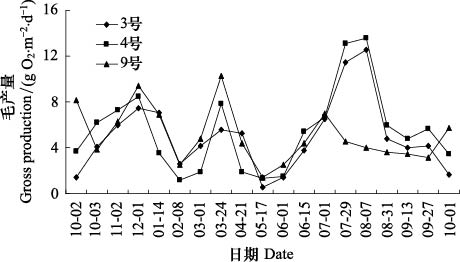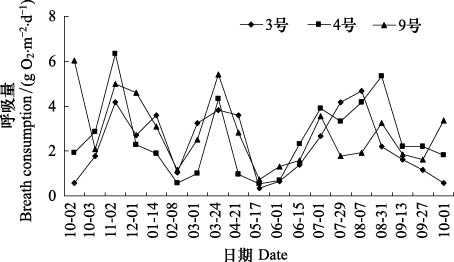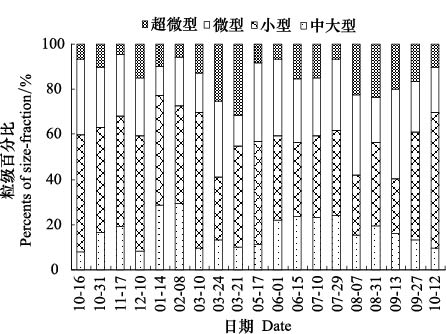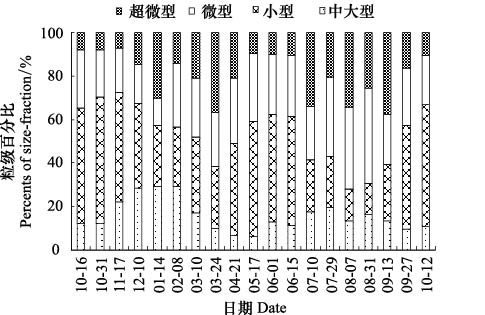文章信息
- 姜森颢, 周一兵, 唐伯平, 蔡勋
- JIANG Senhao, ZHOU Yibing, TANG Boping, CAI Xun
- 刺参养殖池塘初级生产力及其粒级结构周年变化
- Annual variations of the primary productivity and its size-fractioned structure in culture ponds of Apostichopus japonicus Selenka
- 生态学报, 2014, 34(7): 1698-1706
- Acta Ecologica Sinica, 2014, 34(7): 1698-1706
- http://dx.doi.org/10.5846/stxb201304240801
-
文章历史
- 收稿日期:2013-4-24
- 修订日期:2013-11-19
2. 大连海洋大学, 辽宁省海洋生物资源恢复与生境修复重点实验室, 大连 116023
2. Key Laboratory of Marine Bioresources Restoration and Habitat Reparation in Liaoning Province, Dalian Ocean University, Dalian 116023, China
初级生产力是水域生态系统能量流动和物质循环的综合表征,它反映了水体渔业生产的潜力,初级生产力的粒级结构受水文条件、水体化学环境和营养状况等多方面因素的综合作用。初级生产力及其粒级结构共同影响着水域生态系统的次级生产力水平及系统内的生物、化学过程[1, 2, 3, 4]。国内外学者对浮游植物初级生产力的研究较多,涉及不同类型水体初级生产力的时空分布、季节变化、粒级结构及与环境因子的关系等[5, 6, 7, 8, 9, 10, 11, 12],有关刺参养殖池塘基础生态学的深入研究较少[13, 14],对于刺参池塘初级生产力(粒级结构)的实测研究则未见报道。近年来,我国的刺参养殖产业发展迅速,2010年我国海参总产量10万t,产值超过200亿元[15, 16]。刺参已经成为我国单一种类产值最高的水产养殖经济品种。在我国北方,刺参的池塘养殖无论在面积和产量上均是占绝对优势的养殖模式,但对刺参养殖池塘的基础性研究并不系统深入,特别是对某些重要生态学特征及其变化规律的掌握较少。本文从基础生态学的角度出发,研究了刺参养殖池塘初级生产力及粒级结构的特点和较长期的变化规律,旨在深入了解刺参池塘生态系统的结构与功能,为刺参养殖生产提供科学依据。
1 材料与方法 1.1 初级生产力测定与计算试验于2005年10月至2006年10月在辽宁省大连市庄河黄姑咀地区刺参养殖池塘中进行。养殖池塘的基本状况见表 1。浮游植物初级生产力采用黑白瓶氧量法测定,夏、秋季每半月采样1次,冬、春季每月采样1次,采样点和挂瓶点位于池塘中心处。黑白瓶容积为150 mL,依水深和透明度分3或4层悬挂于水中,挂瓶深度一般为20 cm (表层)、透明度的0.5、1、2倍,每层黑、白瓶各2个。采水与挂瓶水层一致。采样时固定原初始溶氧。挂瓶时间为10:00—14:00时,用Winkler法测定溶氧变化量。
| 池塘 Ponds | 3号 No. 3 | 4号 No.4 | 9号 No.9 |
| 面积 Area /hm2 | 2.67 | 3.05 | 3.33 |
| 水深 Water Depth/m | 1.7 | 1.8 | 1.8 |
| 投苗密度 Seeding Density/(个/hm2) | 56620 | 44570 | 48298 |
| 苗种规格 Seeding Size/(g/个) | 1.33 | 1.31 | 1.11 |
| 参礁密度 Density of Settlement Substratum/(个/hm2) | 2222 | 2222 | 2222 |
| 水温 Water temperature/℃ | -1.4—26.5 | -1.4—26.5 | -1.4—26.9 |
| 盐度 Salinity/‰ | 31±3 | 31±3 | 31±3 |
| pH值 | 7.89±0.16 | 8.04±0.13 | 7.90±0.19 |
| 透明度 Transparency/m | 1.02±0.46 | 1.06±0.50 | 0.85±0.55 |
| 氨氮 NH+4-N/(mg/L) | 0.05±0.04 | 0.05±0.04 | 0.04±0.03 |
| 总无机氮 TIN/(mg/L) | 0.267±0.164 | 0.240±0.133 | 0.239±0.143 |
| 磷酸盐磷 PO3-4-P/(mg/L) | 0.012±0.005 | 0.015±0.011 | 0.011±0.006 |
初级生产力计算:各挂瓶水层日产量(gO2 m-3 d-1) 初级毛产量=白瓶溶氧-黑瓶溶氧;初级净产量=毛产量×80%;群落净产量=白瓶溶氧-原初溶氧; 呼吸量=原初溶氧-黑瓶溶氧。水柱日产量即水体初级生产力(gO2 m-2 d-1)为各挂瓶水层日产量之和。根据此结果(占全天总产量的40%)推算全天初级生产力[4]。此外,测定水温、盐度、pH值、透明度及其它主要水化学指标(NH+4-N、NO-3-N、NO-2-N、PO3-4-P、SiO2-3-Si等)。其中,水温、盐度和pH值使用美国YSI 556型多参数水质测量仪测定,透明度使用Secchi盘测定,叶绿素a及水化学参数的测定方法依据对应的国家标准(海洋调查规范GB 12763.4—2007[17]、海洋监测规范GB17378.7—2007[18])进行。
1.2 初级生产力粒级结构测定与初级生产力测定试验同步进行。五点法(池塘四角及中心)采池塘表底水样混合后,分别经200 μm筛绢、20 μm、2 μm、0.2 μm 滤膜(上海新亚,Φ50 mm)抽滤,滤出不同粒级水样置于75 mL黑白瓶中。将分粒级和原水黑白瓶同悬挂于池塘中央水体表层位置,固定原初溶氧,挂瓶时间为10:00—14:00。用Winkler法测定溶氧变化量,通过差减法计算出不同粒级浮游植物(中大型(meso-macro):>200 μm,小型(micro-):20—200 μm,微型(nano-):2—20 μm,超微型(pico-):0.2—2 μm[19, 20, 21])的初级生产量。
1.3 数理统计与分析采用统计软件SPSS Statistics 21.0 对初级生产力与各生态因子分别进行单因素和多元逐步回归分析。单因素回归分析中,以 P<0.05 作为相关性显著的标志;多元逐步回归分析中,为了保留更多的因子,采用了较低的显著性水平(P < 0.1)。
2 结果 2.1 初级生产力的季节变化由图 1、2、3可见,刺参养殖池塘初级生产力季节波动较大,但3个试验池塘总体保持了相同的变化趋势。初级毛产量年平均值为(5.16 ± 3.04) gO2 m-2 d-1,极值为0.53—13.55 gO2 m-2 d-1,不同季节相差较大,其值分别在初春、夏季和初冬形成高峰(图 1);呼吸量年均值为(2.57 ± 1.53) gO2 m-2 d-1,极值为0.34—6.32 gO2 m-2 d-1,分别出现在3号池塘的5月(低值)和4号池塘的11月(高值);群落净产量年均值为(2.62 ± 2.10) gO2 m-2 d-1,极值为0.19—9.89 gO2 m-2 d-1,周年呈现往复上升、下降的波动趋势;试验池塘初级生产力毛产量与呼吸量比值(P/R值)的年平均值为(2.20 ± 1.25),高值出现在3号池塘2005年10月末,低值出现在4号和9号池塘2006年8月末。呼吸量占毛产量的49.8%,群落净产量占毛产量的50.2%。P/R值的年平均值为2.20±1.25,日P/B系数年平均值为0.39 ± 0.35。

|
| 图 1 试验池塘初级生产力毛产量周年变化 Fig. 1 Annual variations of gross primary production in the experimental ponds |

|
| 图 2 试验池塘初级生产力呼吸量周年变化 Fig. 2 Annual variations of respiratory primary production in the experimental ponds |

|
| 图 3 试验池塘初级生产力群落净产量周年变化 Fig. 3 Annual variations of community net production of primary productivity in the experimental ponds |
由图 4可见,试验池塘初级生产力随深度的增加而递减。由于池水表层的光抑制现象,最高生产层通常约在透明度的0.5倍处。3个池塘初级生产力毛产量曲线和呼吸耗氧曲线无交叉,说明补偿深度大于挂瓶水深。水柱日产量PD(gO2 m-2 d-1)和最高生产层生产量Pmax(gO2 m-3 d-1)之间有如下关系:PD=K Pmax · SD 式中SD为透明度(m),K为常数[22]。试验池塘K值年平均值为1.72 ± 0.89。

|
| 图 4 试验池塘初级生产量随水深的变化 Fig. 4 Variations of primary production with water depths in the experimental ponds |
图 5—图 7反映了不同粒级浮游植物初级生产力毛产量(百分比)的周年变化。由图可见,试验池塘不同粒级浮游植物生产量占总生产量百分比的周年波动较大,除夏季外3个池塘均以小型浮游植物(micro-)对总初级生产量的贡献最大,夏季为微型浮游植物(nano-)对初级生产力贡献最大(35.3%);春、夏季以中大型浮游植物(meso-macro)生产量占总初级生产量百分比最小(平均值分别为:12.8% (春)和16.0% (夏)),秋、冬季为超微型浮游植物(pico-)生产量所占的百分比最小(平均值分别为:11.2% (秋)和17.0% (冬))。以年平均值计算,试验池塘不同粒级浮游植物对初级生产力贡献的具体顺序为:小型(40.1%)>微型(28.2%)>中大型(16.1%)>超微型(15.7%)。

|
| 图 5 3号池塘不同粒级浮游植物初级生产力毛产量百分比的周年变化 Fig. 5 Annual variations of the percents of gross primary production of size-fractionated phytoplankton in the number (NO.) 3 pond |

|
| 图 6 4号池塘不同粒级浮游植物初级生产力毛产量百分比的周年变化 Fig. 6 Annual variations of the percents of gross primary production of size-fractionated phytoplankton in the NO.4 pond |

|
| 图 7 9号池塘不同粒级浮游植物初级生产力毛产量百分比的周年变化 Fig. 7 Annual variations of the percents of gross primary production of size-fractionated phytoplankton in the NO.9 pond |
将初级生产力毛产量与水温、盐度、pH值、透明度分别进行单因素回归分析,结果表明:刺参养殖池塘初级生产力受水温影响较大,水温与毛产量之间呈明显的正相关关系(P<0.05)。回归方程为:
PG=0.1383T + 3.2812(n=13,r=0.55,P<0.05)
式中,PG为初级毛产量(gO2 m-2 d-1),T为水温(℃)。透明度、盐度与初级生产力呈不显著的负相关关系(P>0.05),pH值未见与毛产量的显著相关性(P>0.05)。
2.4.2 营养盐和叶绿素a将试验池塘初级生产力毛产量与氨氮、硝酸氮、亚硝酸氮、磷酸盐、硅酸盐分别进行单因素回归分析,结果表明:初级生产力与氨氮、亚硝酸氮均呈显著的正相关关系(P<0.05)。回归方程为:
PG=0.0454N3+ 3.0089(n=19,r=0.48,P<0.05);
PG=0.0635N2+ 3.8316(n=19,r=0.50,P<0.05)
式中,PG为毛产量(gO2 m-2 d-1),N3为氨氮浓度(μg/L),N2为亚硝酸氮浓度(μg/L)。硝酸氮、磷酸盐及硅酸盐对初级生产力的影响未见显著(P>0.05)。为了筛选出显著影响初级生产力的因子,将初级生产力同上述营养盐参数进行多元逐步回归分析,由于分析中单个因子作用变小,采用了较低的显著性水平(0.1),得出方程:
PG= 3.5699 + 8.8623×10-5N3N1+ 7.0106×10-4 N3N2(n=19,r=0.62,α= 0.10,FN3·N2> FN3·N1> F0.10)
式中,N1为硝酸氮浓度(μg/L),其它参数表意及单位同上。由分析结果可知,刺参养殖池塘初级生产力受氨氮与硝酸氮、氨氮与亚硝酸氮交互作用的影响。
将初级生产力与池塘叶绿素a进行回归分析,结果表明:二者之间为极显著的正相关关系(P<0.01)。回归方程为:
PG= 0.0003 Chla3-0.0219 Chla2+0.548 Chla+0.3576 (n=19,r=0.69,P<0.01)
式中,Chla为叶绿素a含量(mg/m3),PG表意及单位同前。
3 讨论浮游植物初级生产力是水生生物生产力的基础,是水域生态系统能量流动和物质循环的关键环节。同国内外其它养殖水体相比,刺参养殖池塘的初级生产力与我国海水(混盐水)养虾池塘处于同一水平[23],低于以色列鲤鱼养殖池塘、印度植食性养鱼池塘以及我国施肥高产鱼池[24, 25, 26],高于胶州湾、三门湾、大亚湾、北部湾和珠江口等海湾、河口水域[27, 28, 29, 30, 31],同时也高于渤海、黄海和东海的近岸、近海[32, 33, 34]。根据以初级生产量水平划分的水体营养类型[19],试验池塘属富营养型水体。影响水体初级生产力的因素除浮游植物本身的生物量变化外,水环境中的光、营养盐、温度以及水体运动等也是重要的影响因素[35]。试验池塘初级生产力毛产量年平均值在夏季达到最高,这主要与夏季光照充足、水温较高,浮游植物光合作用旺盛有关;初级生产力水平在融冰期也有一个明显地提高,这可能与春季水温和营养盐含量的上升有关。
水体P/R值反映了水体初级净产量和外来有机质量的大小。P/R值过大表明水体分解能力较弱,物质循环速率低,初级生产力未被充分利用,P/R值过低则可能导致溶氧状况恶化,天然水体P/R值通常接近1[36]。试验池塘年均P/R值为2.20,明显高于我国以施用有机肥料为主的高产鱼池,也高于混盐水养虾池塘[23]。按水体营养类型划分[19],属富营养型水体。试验池塘较高的P/R值主要是由于养殖动物刺参以底栖藻类和腐屑为主要饵料,对初级生产力利用有限所致。如何充分利用参池的初级生产力,使其更迅速地进入下一营养级,进而被养殖动物利用,以提高刺参次级生产量值得思考。多营养级综合养殖模式的建立(如刺参与滤食性水产动物等的立体混养)可能是解决这一问题的有效方法。P/B系数代表了浮游植物量的周转率,其大小与浮游植物种类组成密切相关,通常藻类细胞越小P/B值越高,淡水浮游植物日P/B值变动于0.1—5.0之间[36, 37]。刺参养殖池塘日P/B系数的平均值为0.39,相对较小,其值与我国的湖泊、水库(0.3—0.8)基本处于同一水平[36]。相对较低的P/B系数,可能是由于浮游植物现存量过大导致自荫作用(shading effects)限制了光合作用。
刺参养殖池塘初级生产力的垂直分布并不均匀,最高生产层(初级生产力最大的水层)约在透明度的0.5倍处,0.5倍透明度(约50 cm)以上水层初级生产量对水柱总产量的贡献近60%。一般而言50 cm以上水层是池塘中光合作用最旺盛、生产力最丰富的水层[38],本试验的研究结果与此现象相一致。试验期间3个池塘的补偿深度均大于挂瓶水深,说明刺参养殖池塘不易形成“氧债层”,这与养殖动物自身的生物学特性、养殖密度、养殖方式(不投饵)和管理模式(大排大灌)等有关,此外,采样天气也是影响因素之一。就此结果评价,1.7 m的平均水深对于北方刺参养殖而言是较为合适的。试验池塘的K值高于海水(混盐水)养虾池塘,低于盐碱养鱼池塘[23, 39]。
3.2 初级生产力粒级结构特点浮游植物初级生产力的粒级结构是水域生态系统中微食物环和粒径谱/生物量谱研究的基础环节,不同粒径浮游植物对初级生产力的贡献不尽相同[40, 41, 42, 43]。刺参养殖池塘不同粒级浮游植物对初级生产力的贡献具有明显的季节变化特点,总体以小型浮游植物(micro-)对水体初级生产力的贡献最大(40.1%)、微型浮游植物(nano-)次之(28.2%)、超微型藻类(pico-)贡献最小(15.7%),小型和微型浮游植物对总初级生产量的贡献近70%。已有的研究表明:粒径小的浮游植物细胞在低营养的水域更具竞争优势,超微藻类在营养物贫乏或营养物间歇供给海域(如海洋上升流区域)占主导地位。随着水体富营养化,水中营养盐累积,生长周期快的小型藻类占优势,超微藻类的丰度下降[44, 45, 46, 47];一般情况下大粒径浮游植物(如小型浮游植物)在温带海域占优势,超微型藻类在热带和亚热带海水中扮演重要角色[8, 48],此趋势与本试验结果相一致。
由于受到“菲律宾黑潮-黄海暖流”的影响,我国北黄海海域浮游植物的生物量和初级生产力等均处于较高水平,在春季小于5 μm的浮游植物是此海区主要的初级生产者[49]。试验刺参养殖池塘位于北黄海沿岸,其以小型浮游植物为主要生产者的粒级结构特点同临近海域有所不同,这与养殖水体自身的营养状况(富营养型水体)有关,同时也可能受到附近入海的淡水河流(如:庄河、英那河等)的影响。
3.3 初级生产力与生态因子大量研究已经表明,不同类型水体的初级生产力会受到诸如水温、盐度、光强和营养盐(氮、磷、硅)等多种生态因子的作用。调查池塘水温变化与初级生产力为显著的正相关关系(P<0.05),三口池塘的毛产量和群落净产量均在夏季出现高峰,此结果与其它水产经济动物养殖池塘的研究结果具有一致性[39, 50],说明了海水温度季节变化在决定初级生产力变化方面具有重要作用。营养盐浓度通常是海洋生态系统中浮游植物生长及其生产力的重要限制因子,而氮和磷又是其中主要的限制因子[20, 51, 52]。刺参养殖池塘的初级生产力受水体中氨氮和亚硝酸氮的作用较为明显(P<0.05),同时氨氮与硝酸氮、氨氮与亚硝酸氮的交互作用也有一定的影响,但磷酸盐和硅酸盐对初级生产力的影响并不显著(P>0.05),仅从实验结果分析,调查池塘为氮限制型水体。叶绿素a是衡量浮游植物现存量的常用指标。刺参养殖池塘初级生产力与叶绿素a之间极显著的相关关系,反映了浮游植物现存量对池塘初级生产力的决定作用,此外浮游植物的种类组成和粒级结构也会影响到其现存量和初级生产力的关系。本研究主要生态学启示之一即揭示了刺参养殖池塘初级生产力同某些生态因子之间存在紧密的相关性。
4 结论本文研究表明,刺参养殖池塘的初级生产力具有明显的季节变化特征,其值在初春、夏季和初冬形成高峰。按生产力水平和P/R值划分,调查池塘属富营养型水体。刺参养殖池塘初级生产力的垂直分布随水深的增加而递减,最高生产层约在透明度的0.5倍处。除夏季外,小型浮游植物(20—200 μm)对初级生产力的贡献最大,夏季微型浮游植物(2—20 μm)为池塘主要的生产者。水温、氨氮和亚硝酸氮均是影响刺参养殖池塘初级生产力水平的重要因子(P<0.05)。
| [1] | Boyd C E. Water Quality Management for Pond Fish Culture. Amsterdam: Elsevier Scientific Publishing Company, 1990: 101-113. |
| [2] | Han M S, Furuya K. Size and species-specific primary productivity and community structure of phytoplankton in Tokyo Bay. Journal of Plankton Research, 2000, 22(7): 1221-1235. |
| [3] | Lieth H, Whittaker R H. Primary Productivity of the Biosphere. New York: Springer-Verlag, 1975: 22-22. |
| [4] | Zhao W, Dong S L, Zhang Z Q, Shentu Q C. Daily change of primary productivity of phytoplankton in saline-alkaline ponds. Chinese Journal of Applied Ecology, 2003, 14(2): 234-236. |
| [5] | Armstrong R, Anderson D W,Callender E.Primary productivity measurements at Devil lake, North Dakota//Proceedings of the North Dakota Academy of Science, 1966, 20: 136-148. |
| [6] | Talling J F, Wood R B, Prosser M V, Baxter R M. The upper limit of photosynthetic productivity by phytoplankton evidence from Ethiopian soda lakes. Freshwater Biology, 1973, 3(1): 53-76. |
| [7] | Herbland A, le Bouteiller A, Raimbault P. Size-structure of phytoplankton biomass in the equatorial Atlantic Ocean. Deep-Sea Research, 1985, 32(7): 819-836. |
| [8] | le Bouteiller A, Blanchot J, Rodier M. Size distribution patterns of phytoplankton in the western Pacific: towards a generalization for the tropical open ocean. Deep Sea Research, 1992, 39(5): 805-823. |
| [9] | Cermeño P, Marañón E, Pérez V, Serret P, Fernández E, Castro C G. Phytoplankton size structure and primary production in a highly dynamic coastal ecosystem (Ría de Vigo, NW-Spain): seasonal and short time scale variability. Estuarine, Coastal and Shelf Science, 2006, 67(1/2): 251-266. |
| [10] | Chen Y L L. Comparisons of primary productivity and phytoplankton size structure in the marginal regions of southern East China Sea. Continental Shelf Research, 2000, 20(4/5): 437-458. |
| [11] | Magazzu G, Decembrini F. Primary production, biomass and abundance of phototrophic picoplankton in the Mediterranean Sea: a review. Aquatic Microbial Ecology, 1995, 9(1): 97-104. |
| [12] | Dugdale R C. The effects of varying nutrient concentration on biological productin in upwelling regions. California Cooperative Oceanic Fisheries Investigations Report, 1985, 26: 93-96. |
| [13] | Ren Y C, Wang F, Dong S L, Liu F. Seasonal characteristicsof primary productionof sea cucumber (Apostichopus japonicus) culture ponds in Jinghai Bay, Rongcheng. Periodical of Ocean University of China, 2010, 40(3): 24-28. |
| [14] | Zhao W, Zhang Y W, Wei J, Yu X H. The structure of suspended particles and sedimentation in cultured ponds of sea cucumber, Apostichopusjaponicus. Acta Ecologica Sinica, 2009, 29(11): 5749-5757. |
| [15] | Jiang S H, Dong S L, Gao Q F, Wang F, Tian X L. Comparative study on nutrient composition and growth of green and red sea cucumber, Apostichopus japonicus (Selenka, 1867), under the same culture conditions. Aquaculture Research, 2013, 44(2): 317-320. |
| [16] | Ministry of Agriculture, People's Republic of China. China Fishery Statistical Yearbook of 2011. Beijing: China Agriculture Press, 2012: 26-26. |
| [17] | General Administration of Quality Supervision, Inspection and Quarantine of the People's Republic of China, China National Standardization Management Committee. Specifications for Oceanographic Survey (GB12763.4). Beijing: Standard Press of China, 2007. |
| [18] | General Administration of Quality Supervision, Inspection and Quarantine of the People's Republic of China, China National Standardization Management Committee. The Specification for Marine Monitoring (GB17378.7). Beijing: Standard Press of China, 2007. |
| [19] | Zhang J M, He Z H. Fisheries Resources Investigation Handbook for Inland Waters. Beijing: Agriculture Press, 1991: 12-12. |
| [20] | Valiela I. Producers and processes involved in primary production//Marine Ecological (second edition). New York: Springer-Verlag, 1995: 3-37. |
| [21] | Sieburth J M, Smetacek V, Kenz J. Pelagic ecosystem structure:heterotrophic compartments of the plankton and their relationship to plankton size fractions. Limnology and Oceanography, 1978, 23(6): 1256-1263. |
| [22] | Wang Y, Wang J. Some problems in the coversion among chlorophylla, biomass and production of phytoplankton. Wuhan Botanical Research, 1984, 2(2): 249-258. |
| [23] | Yan X W, He Z H. Studies on primary production of phytoplankton in shrimp ponds. Journal of Fisheries of China, 1997, 21(3): 288-295. |
| [24] | Zhang Y Z, Tan Y J, Ouyang H. Pond Pisciculture of China. Beijing: Science Press, 1989: 40-88. |
| [25] | Zur O. Primary production in intensive fish ponds and a complete organic carbon balance in the ponds. Aquaculture, 1981, 23(1/4): 197-210. |
| [26] | Morgan N C. Secondary production//le Cren E D, Lowe-MacConnell R H, eds. The Functioning of Freshwater Ecosystems. London: Cambridge University Press, 1980: 247-338. |
| [27] | Sun S, Zhang Y S, Wu Y L, Zhang G T, Zhang F, Pu X M. Annual variation of primary productivity in Jiaozhou Bay. Oceanologia Et Limnologia Sinica, 2005, 36(3): 481-486. |
| [28] | Liu Z S, Zhang J, Cai Y M, Zhang Z D, Liu C G. Primary production and standing stock of the phytoplankton in the Sanmenwan Bay during the summer. Donghai Marine Science, 2003, 21(3): 24-33. |
| [29] | Song X Y, Huang L M, Zhang J L, Yin J Q, Zhang J B, Huang X P. Phytoplankton Biomass, primary production and influence of N/P Ratio on algal growth at Dapeng' Ao Daya Bay, Guangdong Province. Journal of Tropical Oceanography, 2004, 23(5): 34-41. |
| [30] | Liu Z L, Ning X R, Cai Y M. Distribution characteristics of size-fractionated chlorophyll a and productivity of phytoplankton in the Beibu Gulf. Acta Oceanologica Sinica, 1998, 20(1): 50-57. |
| [31] | Cai Y M, Ning X R, Liu Z L. Studies on primary production and new production of the Zhujiang Estuary, China. Acta Oceanologica Sinica, 2002, 24(3): 101-111. |
| [32] | Wang Y, Dou Y, Tang X X, Yang Z. The spatial and temporal distribution of primary production in the Yellow Sea Nearshore area of Shandong Province. Periodical of Ocean University of China, 2009, 39(4): 633-640. |
| [33] | Guan W J, He X Q, Pan D L, Gong F. Estimation of ocean primary production by remote sensing in Bohai Sea, Yellow Sea and East China Sea. Journal of Fisheries of China, 2005, 29(3): 367-372. |
| [34] | Ning X R, Liu Z L, Cai Y M. A review on primary production studies for China seas in the past 20 years. Donghai Marine Science, 2000, 18(3): 13-20. |
| [35] | Falkowski P G, Woodhead A D. Primary Productivity and Biogeochemical Cycles in the Sea. New York: Plenum Press, 1992. |
| [36] | Dong S L, Zhao W. Aquatic Ecology for Aquaculture. Beijing: China Agriculture Press, 2004. |
| [37] | Walters C J, Park R A, Koonce J F. Dynamic models of lake ecosystems//LeCren E D, McConnel R H, eds. The Functioning of Freshwater Ecosystems. Cambridge: Cambridge University Press, 1980: 455-479. |
| [38] | Zhong G F, Wang Z Q, Wu H S. Interactions of Water and Land in Field-Pond System. Beijing: Science Press, 1993: 72-72. |
| [39] | Zhao W, Dong S L, Li D S, Zhang Z Q, Shentu Q C. The primary productivity of phytoplankton in saline- alkaline ponds. Acta Hydrobiologica Sinica, 2003, 27 (1): 47-54. |
| [40] | Montecino V, Quiroz D. Specific primary production and phytoplankton cell size sturcture in an upwelling area off the coast of Chile (30 degree S). Aquatic Sciences, 2000, 62(4): 364-380. |
| [41] | Peña M A, Lewis M R, Harrison W G. Primary productivity and size structure of phytoplankton biomass on a transect of the equator at 135W° in the Pacific Ocean. Deep Sea Research, 1990, 37(2): 295-315. |
| [42] | Kudela R M, Dugdale R C. Nutrient regulation of phytoplankton productivity in Monterey Bay, California. Deep Sea Research Part Ⅱ: Topical Studies in Oceanography, 2000, 47(5/6): 1023-1053. |
| [43] | Wilkerson F P, Dugdale R C, Kudela R M, Chavez F P. Biomass and productivity in Monterey Bay, California: contribution of the large phytoplankton. Deep Sea Research Part Ⅱ: Topical Studies in Oceanography, 2000, 47(5/6): 1003-1022. |
| [44] | Stockner J G, Antia N J. Algal picoplankton from marine and freshwater ecosystems: A multidisciplinary perspective. Canadian Journal of Fisheries and Aquatic Sciences, 1986, 43(12): 2472-2503. |
| [45] | Stockner J G. Autotrophic picoplankton in freshwater ecosystems: the view from the summit. Internationale Revue der Gesamten Hydrobiologie Und Hydrographie, 1991, 76(4): 483-492. |
| [46] | Gobler C J, Cullison L A, Koch F, Harder T M, Krause J W. Influence of freshwater flow, ocean exchange, and seasonal cycles on phytoplankton-Nutrient dynamics in a temporarily open estuary. Estuarine, Coastal and Shelf Science, 2005, 65(1/2): 275-288. |
| [47] | Totti C, Cangini M, Ferrari C, Kraus R, Pompei M, Pugnetti A, Romagnoli T, Vanucci S, Socal G. Phytoplankton size-distribution and community structure in relation to mucilage occurrence in the northern Adriatic Sea. Science of the Total Environment, 2005, 353(1/3): 204-217. |
| [48] | Takahashi M, Bienfang P K. Size structure of phytoplankton biomass and photosynthesis in subtropical Hawaiian waters. Marine Biology, 1983, 76(2): 203-211. |
| [49] | Zhang J T, Yin K D. Distrbutions of size-fractioned Chlorophyll-a and primary production of phytoplankton in spring of the Yellow Sea. Ecology and Environmental Sciences, 2010, 19(9): 2107-2111. |
| [50] | Yao H L. Primary productivity and ecological efficiencies of energy conversion in high output fishponds with Silver Carp, Bighead and Tilapia as the major culture species. Acta Ecologica Sinica, 1993, 13(3): 272-279. |
| [51] | Conley D J, Malone T C. Annual cycle of dissolved silicate in Chesapeake Bay: Implications for the production and fate of phytoplankton biomass. Marine Ecology Progress Series, 1992, 81: 121-128. |
| [52] | Tréguer P, Nelson D M, van Bennekom A J, Demaster D J, Leynaert A, Quéguiner B. The silica balance in the world ocean: A reestimate. Science, 1995, 268(5209): 375-379. |
| [4] | 赵文,董双林,张兆琪,申屠青春. 盐碱池塘浮游植物初级生产力日变化的研究. 应用生态学报,2003,14(2):234-236. |
| [13] | 任贻超,王芳,董双林,刘峰. 荣成靖海湾海参养殖池塘初级生产力季节变化特征. 中国海洋大学学报:自然科学版,2010,40(3):24-28. |
| [14] | 赵文,张义伟,魏杰,于晓辉. 刺参养殖池塘颗粒悬浮物结构及其沉积作用. 生态学报,2009,29(11):5749-5757. |
| [16] | 中国人民共和国农业部. 2012中国渔业年鉴. 北京:中国农业出版社,2012:26-26. |
| [17] | 中华人民共和国国家质量监督检验检疫总局,中国国家标准化管理委员会. 海洋调查规范(GB12763.4). 北京:中国标准出版社,2007. |
| [18] | 中华人民共和国国家质量监督检验检疫总局,中国国家标准化管理委员会. 海洋监测规范(GB17378.7). 北京:中国标准出版社,2007. |
| [19] | 张觉民,何志辉. 内陆水域渔业自然资源调查手册. 北京:农业出版社,1991:12. |
| [22] | 王骥,王建. 浮游植物的叶绿素含量、生物量、生产量相互换算中的若干问题. 武汉植物学研究,1984,2(2):249-258. |
| [23] | 阎喜武,何志辉. 虾池浮游植物初级生产力的研究. 水产学报,1997,21(3):288-295. |
| [24] | 张扬宗,谭玉钧,欧阳海. 中国池塘养鱼学. 北京:科学出版社,1989:40-88. |
| [27] | 孙松,张永山,吴玉霖,张光涛,张芳,蒲新明. 胶州湾初级生产力周年变化. 海洋与湖沼,2005,36(3):481-486. |
| [28] | 刘镇盛,张经,蔡昱明,张志道,刘诚刚. 三门湾夏季浮游植物现存量和初级生产力. 东海海洋,2003,21(3):24-33. |
| [29] | 宋星宇,黄良民,张建林,尹健强,张俊彬,黄小平. 大鹏澳浮游植物现存量和初级生产力及N: P值对其生长的影响. 热带海洋学报,2004,23(5):34-41. |
| [30] | 刘子琳,宁修仁,蔡昱明. 北部湾浮游植物粒径分级叶绿素a和初级生产力的分布特征. 海洋学报,1998,20(1):50-57. |
| [31] | 蔡昱明,宁修仁,刘子琳. 珠江口初级生产力和新生产力研究. 海洋学报,2002,24(3):101-111. |
| [32] | 王悠,窦勇,唐学玺,杨震. 山东近岸黄海海域初级生产力的时空分布变化研究. 中国海洋大学学报:自然科学版,2009,39(4):633-640. |
| [33] | 官文江,何贤强,潘德炉,龚芳. 渤、黄、东海海洋初级生产力的遥感估算. 水产学报,2005,29(3):367-372. |
| [34] | 宁修仁,刘子琳,蔡昱明. 我国海洋初级生产力研究二十年. 东海海洋,2000,18(3):13-20. |
| [36] | 董双林,赵文. 养殖水域生态学. 北京:中国农业出版社,2004. |
| [38] | 钟功甫,王增骐,吴厚水. 基塘系统的水陆相互作用. 北京:科学出版社,1993:72-72. |
| [39] | 赵文,董双林,李德尚,张兆琪,申屠青春.盐碱池塘浮游植物初级生产力的研究. 水生生物学报,2003,27(1):47-54. |
| [49] | 张江涛,殷克东. 黄海春季表层叶绿素和初级生产力及其粒径结构研究. 生态环境学报,2010,19(9):2107-2111. |
| [50] | 姚宏禄. 主养鲢鳙非鲫高产鱼塘的初级生产力与能量转化效率的研究. 生态学报,1993,13(3):272-279. |
 2014, Vol. 34
2014, Vol. 34




